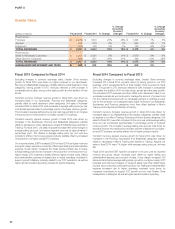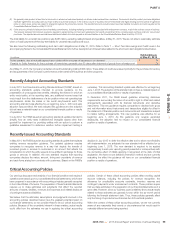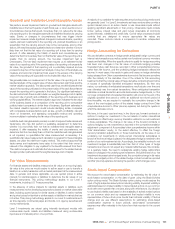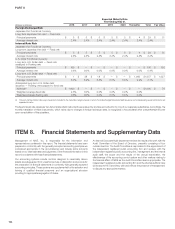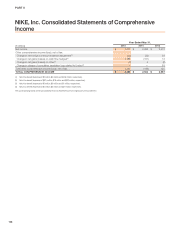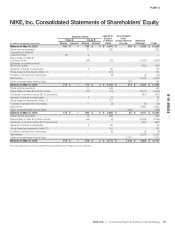Nike 2015 Annual Report Download - page 41
Download and view the complete annual report
Please find page 41 of the 2015 Nike annual report below. You can navigate through the pages in the report by either clicking on the pages listed below, or by using the keyword search tool below to find specific information within the annual report.PART II
Income Taxes
We record valuation allowances against our deferred tax assets, when
necessary. Realization of deferred tax assets (such as net operating loss
carry-forwards) is dependent on future taxable earnings and is therefore
uncertain. At least quarterly, we assess the likelihood that our deferred tax
asset balance will be recovered from future taxable income. To the extent we
believe that recovery is not likely, we establish a valuation allowance against
our net deferred tax asset, which increases our Income tax expense in the
period when such determination is made.
In addition, we have not recorded U.S. income tax expense for foreign
earnings that we have determined to be indefinitely reinvested outside the
United States, thus reducing our overall Income tax expense. The amount of
earnings designated as indefinitely reinvested offshore is based upon the
actual deployment of such earnings in our offshore assets and our
expectations of the future cash needs of our U.S. and foreign entities. Income
tax considerations are also a factor in determining the amount of foreign
earnings to be indefinitely reinvested offshore.
We carefully review all factors that drive the ultimate disposition of foreign
earnings determined to be reinvested offshore and apply stringent standards
to overcome the presumption of repatriation. Despite this approach, because
the determination involves our future plans and expectations of future events,
the possibility exists that amounts declared as indefinitely reinvested offshore
may ultimately be repatriated. For instance, the actual cash needs of our U.S.
entities may exceed our current expectations, or the actual cash needs of our
foreign entities may be less than our current expectations. This would result in
additional Income tax expense in the year we determined that amounts were
no longer indefinitely reinvested offshore. Conversely, our approach may also
result in a determination that accumulated foreign earnings (for which U.S.
income taxes have been provided) will be indefinitely reinvested offshore. In
this case, our Income tax expense would be reduced in the year of such
determination.
On an interim basis, we estimate what our effective tax rate will be for the full
fiscal year. This estimated annual effective tax rate is then applied to the year-
to-date Income before income taxes excluding infrequently occurring or
unusual items, to determine the year-to-date Income tax expense.The
income tax effects of infrequent or unusual items are recognized in the interim
period in which they occur. As the fiscal year progresses, we continually refine
our estimate based upon actual events and earnings by jurisdiction during the
year. This continual estimation process periodically results in a change to our
expected effective tax rate for the fiscal year. When this occurs, we adjust the
income tax provision during the quarter in which the change in estimate
occurs.
On a quarterly basis, we evaluate the probability that a tax position will be
effectively sustained and the appropriateness of the amount recognized for
uncertain tax positions based on factors including changes in facts or
circumstances, changes in tax law, settled audit issues and new audit activity.
Changes in our assessment may result in the recognition of a tax benefit or an
additional charge to the tax provision in the period our assessment changes.
We recognize interest and penalties related to income tax matters in Income
tax expense.
Other Contingencies
In the ordinary course of business, we are involved in legal proceedings
regarding contractual and employment relationships, product liability claims,
trademark rights and a variety of other matters. We record contingent liabilities
resulting from claims against us, including related legal costs, when a loss is
assessed to be probable and the amount of the loss is reasonably estimable.
Assessing probability of loss and estimating probable losses requires analysis
of multiple factors, including in some cases judgments about the potential
actions of third-party claimants and courts. Recorded contingent liabilities are
based on the best information available and actual losses in any future period
are inherently uncertain. If future adjustments to estimated probable future
losses or actual losses exceed our recorded liability for such claims, we would
record additional charges during the period in which the actual loss or change
in estimate occurred. In addition to contingent liabilities recorded for probable
losses, we disclose contingent liabilities when there is a reasonable possibility
that the ultimate loss will materially exceed the recorded liability. While we
cannot predict the outcome of pending legal matters with certainty, we do not
believe any currently identified claim, proceeding, or litigation, either
individually or in aggregate, will have a material impact on our results of
operations, financial position or cash flows.
102


